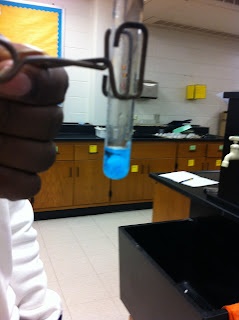Test tomorrow? Study suggestions.
1. Scan chapter 12 in your book. Stop and read if vocabulary terms aren't familiar to you.
2. Read your notes or even scroll down to the last post and open the 3 powerpoints.
Want a short version? Try
sciencegeek.net slideshow Click on the Acids, pH and equilibrium slideshow and then the one for bases.
3.Make a list of things to memorize - strong acids/strong bases/formulas/naming.
4. Look at your multiple choice quizzes.
5. Try the Questions for Review multiple choice!
Try the pH part 2 practice at sciencegeek.net
The lecture notes posted on the blog post below!
Here are the answers to Exercises 12.1 - 12.18
12.1a. HNO2 and NO2- are a pair; water and hydronium
b. phosphate and hydrogen phosphate; HF and F-
12.2 a. water b. H2PO4- (dihydrogen phosphate) c. HC2O4-
12. 3 a. water b. H2PO4- (dihydrogen phosphate) c.sulfate
12.4 a hypochlorous (contains the hypochlorite ion)
b hydrosulfuric acid ( a binary acid)
c oxalic acid (contains oxalate)
d. phosphoric acid (contains phosphate ion)
e. boric acid (contains the borate ion)
12.5 a. Agree Polyprotic means at least TWO H+ are present. If one H+ is donated then another can still be donated.
b. AGREE A negative ion can accept a proton.
c. DISAGREE A positive ion may not have a H+ to donate. (Like metal cations - K+)
12.6 a. hydrogen sulfate ion (acid) carbonate ion (base)
hydrogen carbonate ion (acid) sulfate ion (base)
b. hydrogen sulfate is a stronger aicd than hydrogen carbonate ion (See Ka table.)
c. Stronger to weaker - to the right
12.7 a. 4 b. 2
12.8 1 x 10-6 M
12.9 a. 9 b. x = 1.0 x 10-5 c. Basic More OH- than H+
12.10 a. pH=9 b pH= 12 c. pH= 1
12.11 [OH-] = 10-8
12.12 20 mL KOH
12.13 0.3 M NaOH
12.14 31 mL Ba(OH)2
12.15 a. neutral b. basic c. basic d. acid e. acid f. acid
12.16 Phosphate ion + water <-> hydrogen phosphate ion and HYDROXIDE
12.17 pH= 1.8 SHOW YOUR ICE table
12.18 SHOW TWO ICE TABLES - Solve first for Ka which is 1x 10-6
Use Ka and the 2nd table to solve for a pH of 3.5











